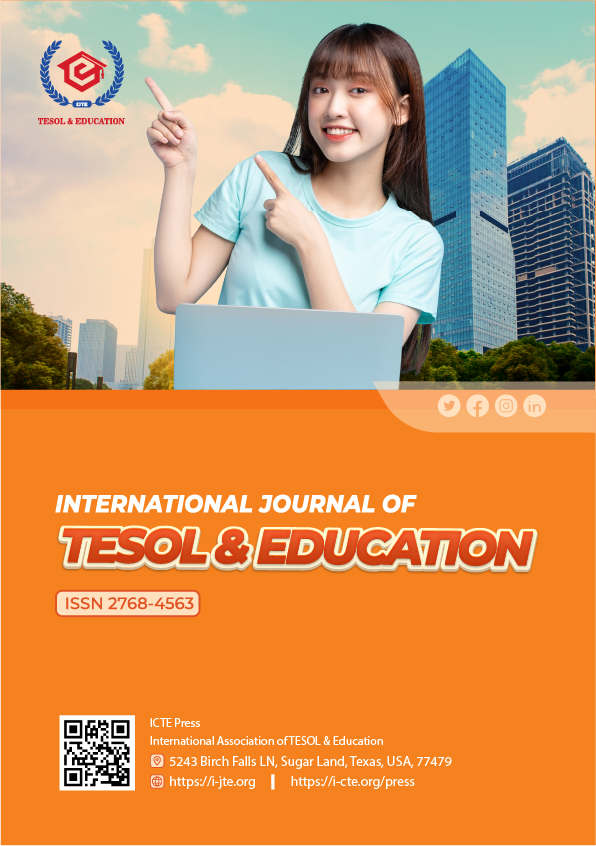Contrastive Analysis of Similes with Dog Image in English and Vietnamese and Implications
DOI:
https://doi.org/10.54855/ijte.24448Keywords:
similes, dog image, contrastive analysis, cross-linguistic, cross-culturalAbstract
Studies on dog images in idiomatic languages in different languages always receive a lot of attention from researchers. The present study examines the similarities of 21 English-Vietnamese dog similes and tries to account for the differences based on Hofstede’s model (2001). The analysis results show that the image of the dog in each language has unique cultural characteristics due to the influence of factors such as geographical circumstances and customs. While the image of a dog appearing in English similes has both positive meaning (38%) and negative meaning (62%), Vietnamese similes record a full dominance in negative meanings (100%). Besides, the semantic symbols of similes with dog elements in Vietnamese and English have interesting similarities. Understanding the semantic characteristics of words for dogs in English and Vietnamese similes contributes to discovering new things about the life, customs, practices, culture, and thinking of British and Vietnamese people.References
Bachrun, N. A. (2023). Metaphors of animal lexeme ‘dog’ in English and Indonesian proverbs: A comparative study. Universitas Gadjah Mada Press.
Bakalová, Marie. (2008). Similes in the British National Corpus. Bachelor’s thesis, Univerzita Palackého v Olomouci.
Brown, H. D. (1994). Principles of language learning and teaching. Englewood Cliffs, NJ: Prentice-Hall.
Cambridge Advanced Learner’s Dictionary (2008.) 3rd ed. Cambridge: Cambridge University Press. Also available at https://dictionary.cambridge.org/
Collins Advanced Learner’s English Dictionary (2006). 5th ed. Glasgow: HarperCollins. Also available at https://www.collinsdictionary.com/
Đặng Thị Thu Hiền (2006). Từ quan niệm về con chó trong tư duy của người Việt. K.Văn- ĐHSP HN.
Farghal, M., & Haider, A. S. (2023). English dog expressions: Categorisation, structure, attitude, semantic molecules, and translatability into Arabic. Training, Language and Culture, 7(3), 41-58.
Ghaemi, H. (2022). Phraseological competence in IELTS academic writing task 2: A study of Indian test-takers’ perceptions and use. International Journal of TESOL & Education, 2(4), 48-70. DOI: https://doi.org/10.54855/ijte.22244
Hoàng Văn Hành (1988). Kể chuyện thành ngữ tục ngữ tập 1, 2. Hà Nội: Nhà xuất bản Khoa học xã hội.
Hoàng Văn Hành (1990). Kể chuyện thành ngữ tục ngữ tập 3. Hà Nội: Nhà xuất bản Khoa học xã hội.
Hoàng Văn Hành (2003). Thành ngữ học tiếng Việt. Hà Nội: Nhà xuất bản Khoa học xã hội.
Hoàng Kim Ngọc (2009). So sánh & ẩn dụ trong ca dao trữ tình. NXB Khoa học.
Hoàng Phê (2011). Từ điển Tiếng Việt. Đà Nẵng: NXB Đà Nẵng
Hoftstede, G. (2001). Culture's consequences (2nd ed.). Thousand Oaks, CA: Sage Publications. https://www.academypublication.com/issues2/tpls/vol07/11/12.pdf
Hưng, Vũ. (2024). A contrastive study of symbolic meanings of “dog” in Chinese and Vietnamese idioms from cognitive perspective. The Journal of Foreign Language Studies. 83-93. 10.56844/tckhnn.74.726.
Hussein, F. R., & Sawalha. M . (2016). A Corpus-based Study of Similes in British and American English. Arab World English Journal, 7(2). DOI: https://dx.doi.org/10.24093/awej/vol7no2.4
Huu Chanh, N. (2021). Simile As An Effective Literary Device in the Vietnamese-English Translation Equivalent. REiLA : Journal of Research and Innovation in Language, 3(2), 115-123. https://doi.org/10.31849/reila.v3i2.6829
Lê Thị Minh Thảo (2014). Vài nét về việc sử dụng hình ảnh “con chó” trong thành ngữ, tục ngữ tiếng Anh và tiếng Việt (The use of “dog” in idioms, proverbs in English and Vietnamese, Tạp chí Ngôn ngữ và đời sống, Số 7 (225)-2014
Ly, C. K. (2022). English-majored Students’ Perceptions of the Translation Course at Ho Chi Minh City University of Food Industry. International Journal of TESOL & Education, 2(3), 63-74. DOI: https://doi.org/10.54855/ijte.22235
Nguyễn Nhật Quang (2020). A comparative and contrastive study on proverbs showing determination in English and Vietnamese language from intercultural perspectives. Tạp Chí Khoa học Ngoại ngữ, 1(61), 13–25. https://doi.org/10.56844/tckhnn.61.42
Oxford Dictionary of English Idioms. (2010). 3rd edition. Oxford University Press. Also available at http://www.oed.com/.
Phạm Ngọc Hàm (2018). “Chó” trong ngôn ngữ và văn hóa Trung-Việt (Dogs in Vietnamese and Chinese languages and cultures). Tạp chí Nghiên cứu Nước ngoài, Tập 34, Số 1 (2018) 59-69
Phuong Vu Mai (2024) Idiomatic Similes in English and Vietnamese: A Contrastive Analysis. (2024). Journal of Educational and Social Research, 14(4), 396. https://doi.org/10.36941/jesr-2024-0110
Ranti, Maulidyanti., Novi, Noor, Hayati., Herniwati, Herniwati. (2023). Contrastive Analysis of the Meaning of Japanese and Indonesian Proverbs Formed from Words 犬 (Dog) and 猫 (Cat). Jomantara, International Journal of Art and Culture, 62-69. doi: 10.23969/jijac.v3i1.7059
Vũ Ngọc Phan (2005). Tục ngữ, thành ngữ, ca dao Việt Nam. NXB Văn học
Downloads
Published
Issue
Section
License
Copyright (c) 2024 Le Hoai Thu

This work is licensed under a Creative Commons Attribution 4.0 International License.
The copyright of all articles published in the International Journal of TESOL & Education (ijte) remains with the Authors, i.e. Authors retain full ownership of their article. Permitted third-party reuse of the open access articles is defined by the applicable Creative Commons (CC) end-user license which is accepted by the Authors upon submission of their paper. All articles in the ijte are published under the CC BY-NC 4.0 license, meaning that end users can freely share an article (i.e. copy and redistribute the material in any medium or format) and adapt it (i.e. remix, transform and build upon the material) on the condition that proper attribution is given (i.e. appropriate credit, a link to the applicable license and an indication if any changes were made; all in such a way that does not suggest that the licensor endorses the user or the use) and the material is only used for non-commercial purposes.
Authors retain copyright and grant the journal the right of first publication with the work simultaneously licensed under a Creative Commons Attribution 4.0 International License that allows others to share the work with an acknowledgment of the work's authorship and initial publication in this journal.
Authors are able to enter into separate, additional contractual arrangements for the non-exclusive distribution of the journal's published version of the work (e.g., post it to an institutional repository, in a journal or publish it in a book), with an acknowledgment of its initial publication in this journal.











